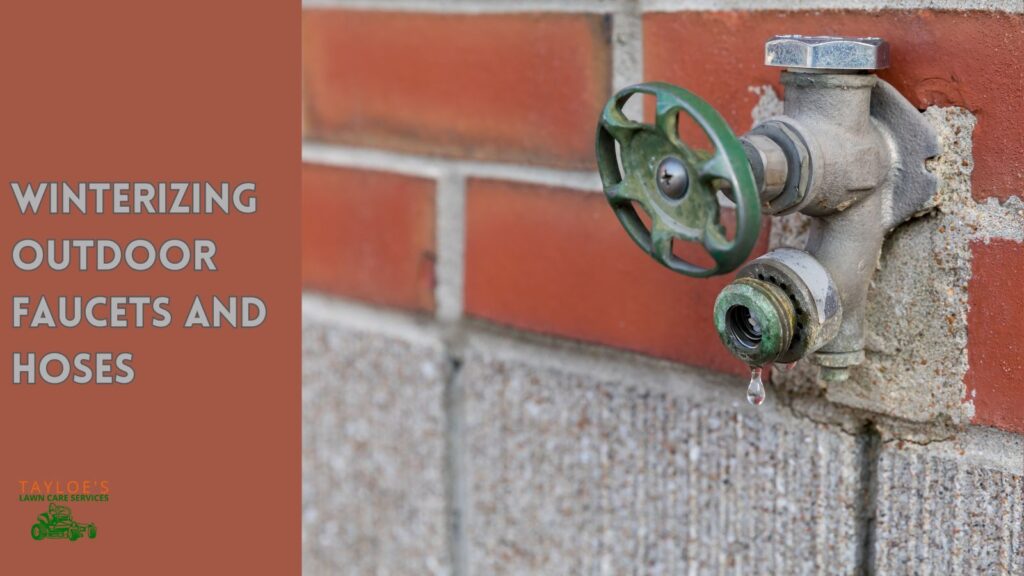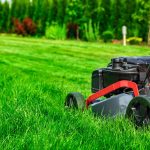Last Updated on: 14th December 2023, 07:41 pm
Winterizing your mower will help it last longer and cause less aggravation.
As the winter season approaches, taking the appropriate steps to winterize your gas lawn mower becomes necessary. Winterizing your mower is essential to prevent any potential problems when starting it up again in the spring. Following a few simple steps, you can ensure that your gas lawn mower remains in good condition and ready for use when the grass grows again.
To begin with, let’s take a closer look at why it is essential to winterize a gas lawn mower. Winterizing helps to protect the engine and other vital components of the mower from the harsh winter conditions. Cold temperatures and moisture can cause fuel lines to clog, oil to thicken, and various parts to corrode. By winterizing your mower, you can prevent these issues and ensure that it starts up smoothly when you need it again in the spring.
Now, let’s provide an overview of the steps involved in winterizing a gas lawn mower. The same basic steps apply to a push mower or a riding mower – as long as it’s a gas-powered lawn mower.
Winterizing typically includes draining the fuel and oil, cleaning the mower, storing it properly, and performing necessary maintenance tasks. In the following sections, we will delve into each of these steps in more detail to provide you with a comprehensive guide to winterizing your gas lawn mower.
Before you start, remember to grab gloves, eye protection, and other safety gear as needed. Always be sure the engine can’t fire while you work on it.

Drain the Fuel and Oil from a Gas Lawn Mower
One of the most crucial steps in winterizing your gas lawn mower is draining the fuel and oil. This is important to prevent any clogged fuel lines. It will also help your mower start up smoothly in the spring. When fuel and oil are left sitting in the mower over the winter, they can degrade and cause damage to the engine.
To drain the fuel and oil from your gas lawn mower, follow these step-by-step instructions:
- Run the mower until it runs out of fuel, or use a fuel siphon to remove the fuel from the tank. This helps to prevent any leftover fuel from clogging the fuel system during the winter months.
- Removing the spark plug wire once the fuel has been drained will prevent any accidental starting while you work on the mower.
- Next, tilt the mower on its side and carefully drain the oil through the oil fill tube into a suitable container. This helps to remove any old or contaminated oil that may be present in the mower.
- It is essential to dispose of the old fuel and oil properly. Check with your local waste disposal facility or recycling center for guidance on safely and responsibly disposing of these materials.
Why is this necessary?
By removing the fuel and oil, you can prevent any potential issues that may arise from old or degraded fuel and oil during the winter months.
Cleaning the Mower Blades and Deck
Cleaning your gas lawn mower before winter storage is an essential step to prevent moisture and corrosion. During the mowing season, grass clippings, dirt, and debris can accumulate on the mower’s deck and other areas. If left uncleaned, these can lead to rust and other damage. Therefore, you should clean your mower thoroughly before storing it for the winter.
To clean your gas lawn mower effectively, follow these instructions:
- Start by scraping the mower’s undercarriage to remove any accumulated grass clippings and debris. A putty knife or a wire brush can be used for this purpose.
- Next, hose off the outside of the mower to remove dirt and debris that may have collected on the surface. Use a gentle spray to avoid forcing water into any sensitive areas of the mower.
- Clean the mower deck using a garden hose or a pressure washer. This will help to remove any remaining grass clippings and dirt. Make sure to direct the water away from any electrical components or the engine.
- For any dried-on clippings that are difficult to remove, you can use a plastic paint scraper or a bristled pot scrubber to remove them gently. Take care not to scratch or damage the surface of the mower.
- To prevent future buildup, spray the underside of the deck with silicone spray. This will act as a protective barrier, making grass clippings and debris harder to stick to the surface.

Why is this necessary?
By cleaning your mower thoroughly, you can ensure that it is free from any dirt or debris that could cause damage during storage and potentially affect its performance in the future.
Storing the Mower Properly
Proper storage of your gas lawn mower during the winter months. That’s because an adequate shelter can prevent any damage and ensure easy startup in the spring. Storing your mower correctly will help protect it from the elements and maintain its condition. Here are some tips for storing your mower properly:
- Store the mower in a dry location – a shed or garage. This will help protect it from moisture and prevent rust from developing on metal components.
- Cover the lawn mower with a tarp or garbage bag to protect it from dust and debris. Make sure the cover is securely fastened to prevent moisture from getting inside.
- It is recommended to store the mower with a full tank of fuel. This helps to prevent moisture from accumulating in the tank, reducing the risk of rust formation.
- Spray the battery terminals with an anti-corrosion spray, available at an auto retail store. Ideally, you would put the battery on a battery tender to maintain the charge during the winter. Remove the battery from the mower and store it in a cool, dry place if that’s impossible. Extreme temperatures can damage the battery, so a controlled environment is essential.
Why is this necessary?
By following these storage tips, you can keep your gas lawn mower in good condition and ensure that it is ready for use when the mowing season begins again.
Maintaining a Gas Lawn Mower During Winter
While your gas lawn mower is in storage during the winter, there are a few additional steps you can take to maintain its performance. These steps will help ensure that your mower is in optimal condition when you fire it up again in the spring.
- Consider sharpening and balancing the blade before storing the mower. A sharp and balanced blade will ensure cleaner cuts and a healthier lawn when you cut grass in the spring.
- It is also recommended to consider changing the spark plug and air filter. Over time, these components may become worn or dirty, decreasing the mower’s performance. By replacing them, you can help improve the efficiency and effectiveness of your mower.
- Optional steps such as an oil change and cleaning or replacing the air filter can also be performed for added maintenance. Please see your manufacturer’s suggested intervals. These tasks ensure that the mower’s engine remains in good working condition while stored for the winter.
Why is this necessary?
By performing these maintenance tasks, you can ensure that your gas lawn mower remains in good working condition during the winter months. Therefore, the machine is ready for use when the mowing season begins again.
Additional Tips for Winterizing
In addition to the essential steps mentioned earlier, here are some additional tips to consider when winterizing your gas lawn mower:
- When covering the mower with a tarp or garbage bag, ensure it is securely fastened to protect it from moisture and pests. This will help prevent any damage caused by moisture or pests during winter.
- Check the tire pressure and adjust it as needed. Properly inflated tires will maintain their shape and prevent flat spots during storage. For a riding mower, park the mower on patio pavers, concrete, or packed gravel to avoid dry rot. This will help ensure that your mower is ready for use when the mowing season begins again.
- If you don’t have a heated shed or garage, consider using a fuel stabilizer to prevent fuel from freezing and causing damage to the mower. Fuel stabilizers are additives that help protect the fuel from degradation and maintain its quality during storage.
By following these additional tips, you can further enhance the winterization process and ensure that your gas lawn mower is well-protected and ready for use in the spring.
Professional Services for Winterizing a Gas Lawn Mower
While many homeowners choose to winterize their gas lawnmowers themselves, professionals available for those who prefer to leave the task to experts. Hiring a professional can offer several benefits, including saving time and ensuring the winterization process is done correctly.
Professional services for winterizing gas lawn mowers typically have the expertise and knowledge to handle the task efficiently. They are familiar with the specific requirements of different mower models and can perform the necessary steps to winterize your mower effectively. Additionally, they may offer additional services such as blade sharpening, oil changes, and general maintenance.
If you prefer to have your gas lawn mower winterized by a professional, you can search for local lawn mower service centers or outdoor power equipment stores. These establishments often have experienced technicians who can provide expert advice and perform the necessary winterization tasks for your mower.
While hiring a professional service for winterizing your gas lawn mower is an option, it is essential to note that you can also perform the winterization steps yourself with the proper knowledge and tools. By following the guidelines provided in this article, you can successfully winterize your gas lawn mower and ensure its optimal performance in the spring.

The Takeaway: Winterizing Your Gas Mower Keeps it Running Well
Winterizing your gas lawn mower is crucial to protect it from potential damage during the winter months. Following the steps outlined in this article can ensure that your gas lawn mower remains in good condition when the mowing season begins again.
Remember to drain the fuel and oil from your mower, clean it thoroughly to prevent moisture and corrosion, store it in a dry location with a full tank of fuel, and consider performing maintenance tasks such as sharpening the blade and changing the spark plug and air filter. Additionally, follow the additional tips provided to enhance the winterization process and ensure that your gas lawn mower is well-protected during the winter months.
Winterizing your gas lawn mower properly will extend its lifespan. It will also ensure that it performs optimally when you need it again in the spring. So, please don’t neglect this vital task and give your gas lawn mower the care it deserves during winter. Love our lawn care tips? Follow us on Facebook. Or, if you want to leave your lawn care needs to our team, connect by calling or texting 252.2587.3376.
Author Profile

- Randy Tayloe is the COO of Tayloe's Lawn Care Service, LLC. He is a certified custom applicator, recognized by the North Carolina Department of Agriculture Pesticide Division. A native of Bertie County, NC, and graduate of Bertie High School, he wants to beautify his home county - one yard at a time.
Latest entries
 FaunaOctober 3, 2025Fall decorations that endanger wildlife (and how to avoid the risks)
FaunaOctober 3, 2025Fall decorations that endanger wildlife (and how to avoid the risks) GardeningApril 1, 2025Fountain grasses add colorful foliage and movement
GardeningApril 1, 2025Fountain grasses add colorful foliage and movement GardeningMarch 21, 2025White cloud muhly grass growing guide
GardeningMarch 21, 2025White cloud muhly grass growing guide Lawn CareFebruary 25, 2025Should I mow every week?
Lawn CareFebruary 25, 2025Should I mow every week?







